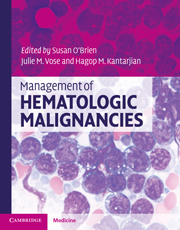Book contents
- Frontmatter
- Contents
- List of contributors
- 1 Molecular pathology of leukemia
- 2 Management of acute myeloid leukemia
- 3 Treatment of acute lymphoblastic leukemia (ALL) in adults
- 4 Chronic myeloid leukemia
- 5 Chronic lymphocytic leukemia/small lymphocytic lymphoma
- 6 Myelodysplastic syndromes (MDS)
- 7 Hairy cell leukemia
- 8 Acute promyelocytic leukemia: pathophysiology and clinical results update
- 9 Myeloproliferative neoplasms
- 10 Monoclonal gammopathy of undetermined significance, smoldering multiple myeloma, and multiple myeloma
- 11 Amyloidosis and other rare plasma cell dyscrasias
- 12 Waldenstrom's macroglobulinemia/lymphoplasmacytic lymphoma
- 13 WHO classification of lymphomas
- 14 Molecular pathology of lymphoma
- 15 International staging and response criteria for lymphomas
- 16 Treatment approach to diffuse large B-cell lymphomas
- 17 Mantle cell lymphoma
- 18 Follicular lymphomas
- 19 Hodgkin lymphoma: epidemiology, diagnosis, and treatment
- 20 Treatment approaches to MALT/marginal zone lymphoma
- 21 Peripheral T-cell lymphomas
- 22 Mycosis fungoides and Sézary syndrome
- 23 Central nervous system lymphoma
- 24 HIV-related lymphomas
- 25 Lymphoblastic lymphoma
- 26 Burkitt lymphoma
- Index
- References
4 - Chronic myeloid leukemia
Published online by Cambridge University Press: 10 January 2011
- Frontmatter
- Contents
- List of contributors
- 1 Molecular pathology of leukemia
- 2 Management of acute myeloid leukemia
- 3 Treatment of acute lymphoblastic leukemia (ALL) in adults
- 4 Chronic myeloid leukemia
- 5 Chronic lymphocytic leukemia/small lymphocytic lymphoma
- 6 Myelodysplastic syndromes (MDS)
- 7 Hairy cell leukemia
- 8 Acute promyelocytic leukemia: pathophysiology and clinical results update
- 9 Myeloproliferative neoplasms
- 10 Monoclonal gammopathy of undetermined significance, smoldering multiple myeloma, and multiple myeloma
- 11 Amyloidosis and other rare plasma cell dyscrasias
- 12 Waldenstrom's macroglobulinemia/lymphoplasmacytic lymphoma
- 13 WHO classification of lymphomas
- 14 Molecular pathology of lymphoma
- 15 International staging and response criteria for lymphomas
- 16 Treatment approach to diffuse large B-cell lymphomas
- 17 Mantle cell lymphoma
- 18 Follicular lymphomas
- 19 Hodgkin lymphoma: epidemiology, diagnosis, and treatment
- 20 Treatment approaches to MALT/marginal zone lymphoma
- 21 Peripheral T-cell lymphomas
- 22 Mycosis fungoides and Sézary syndrome
- 23 Central nervous system lymphoma
- 24 HIV-related lymphomas
- 25 Lymphoblastic lymphoma
- 26 Burkitt lymphoma
- Index
- References
Summary
Introduction
Chronic myeloid leukemia (CML) is a relatively rare disease but is one of the most extensively studied and best understood neoplasms, and one for which a direct gene link has been found. CML is characterized by a balanced genetic translocation, t(9;22)(q34;q11.2), involving a fusion of the Abelson oncogene (ABL) from chromosome 9q34 with the breakpoint cluster region (BCR) gene on chromosome 22q11.2. This rearrangement is known as the Philadelphia chromosome (Ph). The molecular consequence of this translocation is the generation of a BCR-ABL fusion oncogene, which in turn translates into a Bcr-Abl oncoprotein. Bcr-Abl displays transforming activity owing to its constitutive kinase activity, which results in multiple signal transduction pathways leading to uncontrolled cell proliferation and reduced apoptosis and resulting in the malignant expansion of pluripotent stem cells in bone marrow. CML is usually diagnosed in the chronic phase (CP) and, if not treated, progresses through an accelerated phase (AP) to a terminal blastic phase (BP).
Incidence, epidemiology, and etiology
CML accounts for 15% to 20% of cases of leukemia in the United States. There is a slight male preponderance. Its annual incidence is about 1 to 2 cases per 100,000 individuals. About 5000 to 6000 cases of CML are diagnosed annually. This incidence has not changed over the past few decades, and increases with age. The median age at CML diagnosis is 55 to 60 years; it is uncommon in children and adolescents. Before imatinib therapy, the prevalence of CML was about 25,000 cases in the United States.
- Type
- Chapter
- Information
- Management of Hematologic Malignancies , pp. 68 - 80Publisher: Cambridge University PressPrint publication year: 2010



